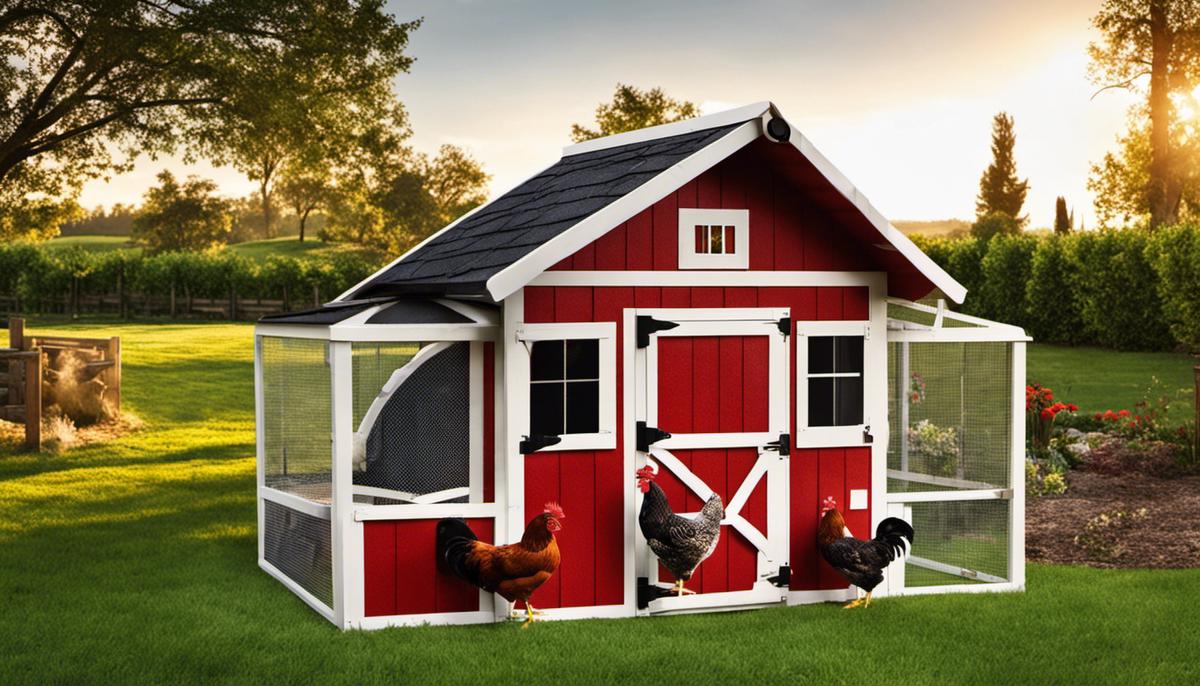“Welcome to ‘Your Guide to Creating a Chicken Coop in (2024).’ Whether you’re nestled in the countryside, embracing suburban tranquility, or navigating the urban landscape, the allure of raising chickens at home continues to grow. This guide serves as your compass through the process of creating chicken coops that harmonize with your surroundings, offering insights into design, construction, and maintenance. Join us on this journey to not only build a functional space for your feathered companions but also to foster an environment where they can thrive, tailored to the needs of your flock.
We will receive a commission if you purchase through our affiliate link at no extra cost to you. Please read our disclosure policy for more information.
Designing the Chicken Coop
Essential considerations for anyone who has ever fancied the idea of raising chickens in your backyard, we’ll jump straight into the heart of the matter: building a chicken coop. This endeavor involves careful planning and consideration, extending far beyond just another family DIY project. So, sit back, relax, and let’s delve into the key considerations when designing your chicken coop.
Location:
First things first, location is pivotal. Just like building a home, where you construct the coop matters a great deal. Seek out an area that offers the coop ample sunlight during early hours, but also has shade in the afternoons to give the chickens a respite from the heat.
Ensure the chosen area is not prone to flooding and consider the proximity to your house. Remember, you’ll need to collect eggs, feed, and water the chickens daily. Accessibility is key, so don’t locate your coop a strenuous trek away.
Size:
The right size and design of the chicken coop is also significant. The general rule of thumb is to allocate at least 4 square feet per chicken inside the coop, and about 10 square feet in the chicken run. Supply adequate roosting bars for sleeping and nesting boxes for laying eggs.
Ventilation:
Ventilation is crucial to keep the coop from getting too stuffy, while insulation is necessary to keep your flock warm during winter months. Vertical sliding windows work wonders in delivering both. During warmer months, they can be opened for ventilation, and during colder months they can be shut for insulation.
Predators:
Opt for predator-proofing measures, since chickens harbor many natural enemies, from raccoons to hawks. Ensure the coop is fully enclosed, including the outdoor run. Go for sturdy wire mesh fencing and add a predator apron around the perimeter to prevent digging underneath.
Building the floor from concrete is another solid way to keep predators at bay, in addition to providing an easy-to-clean surface. Consider applying a layer of straw on top of concrete floors for warmth and added comfort.
Maintenance:
Remember that cleanliness is essential in coops. A straightforward way to keep a chicken coop clean is to incorporate a design that allows for easy cleaning and maintenance. Sliding trays or doors for easy access, removable roosting bars, and washable nest boxes are some helpful design features.
Food and Water:
Incorporate the provision of food and water within the coop plans. Fitted feeders and water containers not only keep the food and water clean but also prevent wastage by spillage.
Family:
Finally, it can be delightful to add personalized touches to the chicken coop. Paint it in cheerful colors, add signs, or experiment with unique architectural designs. Don’t forget to engage your whole family in this project, as it can be a wonderful bonding and learning experience for everyone.
So, there you have it! So when it comes to creating a chicken coop raise your (presumably dusty) gloves in salutation, because you’re now ready to tackle designing a chicken coop. It isn’t just about housing chickens, after all—it’s about creating a secure, comfortable, and healthy environment for your feathery friends to thrive. Happy building!
Here are a couple of sources for some DIY plans. Chicken Coop Plans.
Here is another for Free Chicken Coop Plans.

One additional thing to keep in mind when planning out your coop is how many chickens you would like to keep, for more information on how many chickens to keep, check out my article: Chicken Coop Space How Many Chickens To Keep.
Building the Chicken Coop
Practical Tips beyond the Basic Chicken Coop
Keeping chickens in the backyard can be a remarkable experience, offering the dual benefits of fresh eggs and the joy of animal companionship. Once the basics of the chicken coop are in place, there are a few additional elements to consider ensuring your feathered friends lead a healthy, happy life.
Firstly, it’s significant to build an outdoor area or ‘run’ attached to the coop. Chickens thrive on a daily dose of fresh air and need plenty of space to ‘do their thing’ – scratch, peck, and sunbathe. The run should hence be significantly spacious, minimally twice the area of the coop itself. Incorporate bird netting or chicken wire on the top to keep aerial predators away.
You can either build a run that you design, or purchase a premade Chicken Run.
I’m also giving you a link to some coops with runs built into them, Chicken Coop and Run.

Next, focus on providing an ample amount of perching space inside the coop. Chickens are traditionally woodland animals and prefer to sleep up high to feel safe from predators. Installed on varying heights, the perches also help establish a hierarchy among the flock, based on who gets the highest perch, learn more. Chicken Perch

The Pole Tree is an innovative and strong perch system that offers your hens custom made perching at any height and orientation in their run. Suitable for all types of chicken enclosures, this adjustable perch tree will provide your flock with entertainment and stimulation for years to come!
Dust Bath
Be sure to include a dust bath area in your run, Chickens love to ‘bathe’ in dirt to keep their feathers clean and to ward off parasites. A simple wooden frame filled with a blend of fine sand, dry dirt, and diatomaceous earth works perfectly as a dust bath.

Chickens are natural foragers and will spend a significant part of their day pecking around in search of food. To mimic this, scatter their favorite treats like grains, fruits, or vegetables throughout the run. This not only keeps them occupied, but it also provides mental stimulation.
Healthcare
Lastly, pay attention to the occasional need for ‘chicken healthcare.’ Check your chickens routinely for lice, mites, or any other signs of distress. Keeping a first aid kit ready with all chicken healthcare essentials like wound sprays, vet wrap, and supplements can be a lifesaver in times of an emergency.
Here is my recommended First Aid Kit
In conclusion, a well-planned, well-executed chicken coop with a farmhouse appeal is only the beginning of the journey of backyard chicken keeping. What follows is embracing a lifestyle that involves regular interactions, dedicated care, and a love for these lovely creatures! When you look outside to see them happily clucking away, scratching at the dirt, you’ll know the effort invested is worth every bit.
Maintaining the Chicken Coop
Starting up a chicken coop in your backyard can be one of the most rewarding adventures for your family. Not only does it provide ongoing educational experiences for your little ones, but it also lets you produce healthy homegrown eggs that taste noticeably better than store-bought! So, let’s dive into the essential strategies to keep a chicken coop clean and functional.
First up, let’s talk about beddings. A thick layer of organic bedding plays a crucial role in ensuring a clean chicken coop. Aspen shavings, hay, straw, or even dried leaves can be used. The advantage of using organic materials is that they compost over time, which can benefit your garden. This layer absorbs droppings and odors, acting as a natural air filter and ensuring a fresh environment for the chickens.
To learn more about keeping your coop clean, read my article about: Maintaining Your Chicken Coop
Daily inspections should not be overlooked. Stepping into the coop each day is crucial. This habit makes it easier to spot any issues before they develop into bigger problems. Collect eggs, replace food and water, and look out for any signs of pests or diseases.
Cleaning:
Then there’s the “deep cleaning.” Seasonal deep cleaning every three to four months is advisable. This means removing all bedding, washing all surfaces with a chicken-friendly disinfectant, cleaning feeding and watering containers, and adding fresh bedding. It’s also a great opportunity to inspect for any wear and tear in the coop that may need repairing.
Organizing a compost pile can be another effective addition to your chicken care routine. Composting chicken litter can enrich the soil in your garden. The compost has to be turned regularly for proper aeration and faster composting. Be sure to wait until the compost is fully mature before using it in your garden to avoid harmful bacteria or pathogens.
Feed:
Remember, healthy chickens need a proper diet. Feed your chickens a well-balanced diet to keep them healthy. Healthy chickens are less likely to get sick and make a mess in the coop. Supplement their diet with kitchen scraps, but steer clear from anything toxic like chocolate, coffee grounds, or any moldy foods.
To learn more about chicken feed and what you should be feeding your chickens, check out my article: Understanding Chicken Feed A Comprehensive Guide.
To avoid mess, it’s helpful to train chickens to use nesting boxes. Encouraging the chickens to lay eggs in the nesting boxes rather than anywhere in the coop helps to maintain cleanliness. Make the nesting boxes comfy for the chickens to encourage this behavior.
Last but definitely not least, ensure good coop drainage. Make sure your coop stays dry inside. If you notice any leaks or standing water, address that immediately to prevent dampness and the possible growth of harmful bacteria.
Time:
Managing a chicken coop involves effort and dedication. But focus on creating a healthy environment for your chickens, and they’ll reward you and your family with a bountiful supply of fresh eggs and endless fun. Enjoy the journey!

A well-designed, well-built, and well-maintained chicken coop is more than just a structure; it is a commitment to animal care and sustainable living. Introducing this level of conscientious living into our everyday routines amplifies connections to nature and food sources, encourages responsible stewardship, and lends itself toward a lifestyle of sustainability. By considering the design elements, understanding the construction process, and undertaking suitable maintenance measures, you can provide a healthy, spacious and safe environment for your chickens. And remember, a happy hen lays healthier eggs. With this knowledge at your fingertips, you are well on your way to becoming an exemplary backyard farmer!
Looking for more information, review my article: Guide To Building Your Own Chicken Run.







